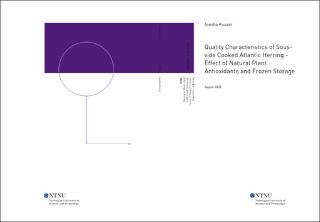| dc.description.abstract | Atlantic herring has a high nutritional value and is a good source of lipids with a high content of PUFAs (polyunsaturated fatty acids) in addition to protein, minerals (calcium, phosphorus, magnesium) and vitamins (A, D). Herring has a high content of EPA (eicosapentaenoic acid) DHA (docosahexaenoic acid) as well as some monounsaturated fatty acids. Numerous health benefits are related to the high lipid content and nutritional profile of herring.
Partially cooked ready to eat, finished products of fish are preferred more over fresh fish due to their palatability and convenience. Unfortunately, auto-oxidation is a huge problem in finished and frozen fish products particularly in fatty fish such as herring. Lipid oxidation causes organoleptic changes and results in loss of the nutritional quality of fish products. Therefore, it is of utmost importance to explore ways to increase stability during prolonged storage of the finished products.
The main aim of this study was to evaluate the effects of different natural antioxidants (oregano, nettle, dill, olive leaf extract) on preserving the quality of sous vide cooked herring fillets during frozen storage (at -20°C). Peroxide value (PV), conjugated dienes (CDs), conjugated tetraenes (CTe), and TBARS were performed to determine the status of primary and secondary oxidation in frozen herring samples. The reduced peroxide content, TBARS values, and CDs compared to the Control indicated the effect of the antioxidants used, particularly nettle and oregano that more efficiently reduced the values.
The same fillets were further frozen stored for 5 months and analyzed for the sarcoplasmic protein solubility and thiol content to study the effects on solubility and oxidation of proteins. The increased solubility and decreased thiol content indicated that structural changes in proteins had taken place during the frozen storage.
Additionally, the two antioxidant extracts (oregano, dill) were investigated for the antioxidant potential using ABTS, DPPH, Folin Ciocalteau assays. Oregano was found to be a more potent antioxidant than dill and its PG equivalence was considerably higher than dill in all three assays. Oregano and nettle can be effective in increasing the oxidative stability in partial cooked ready to eat fish products. | |
